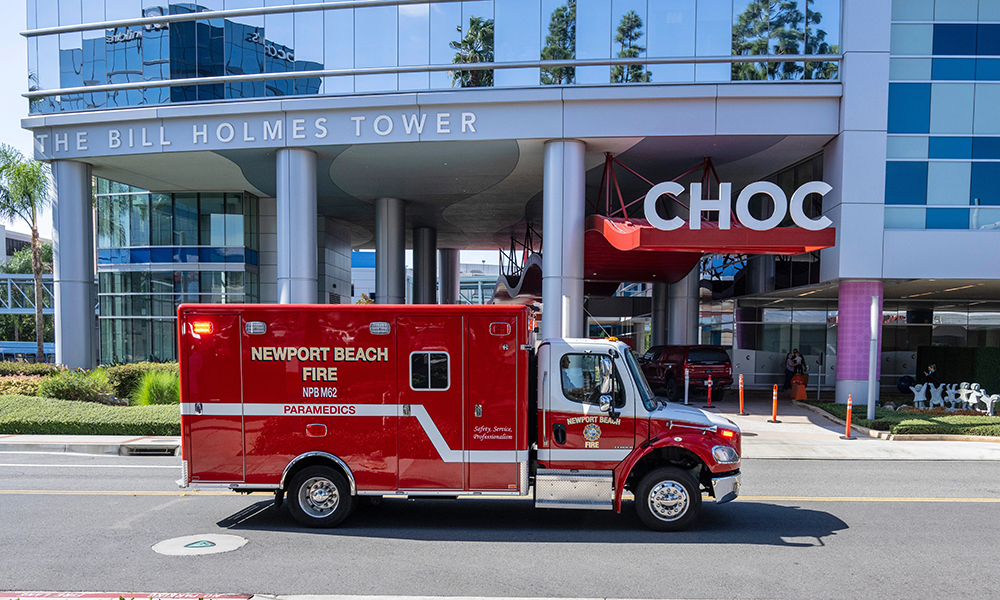美国陷入“三重疫情”,儿童频发呼吸道疾病,医院不堪重负

今年秋季,流感、呼吸道合胞病毒(RSV)和新冠病毒导致的“三重疫情”令北美儿童医院达到极限。有些儿童医院迫切需要额外空间和人手,甚至考虑在停车场设立“临时帐篷”,并向美国国民警卫队(National Guard)求助。
圣迭戈雷迪儿童医院(Rady Children’s Hospital-San Diego)尚未面临这样的困境。该医院的高级副总裁兼首席运营官、小儿泌尿科医生尼古拉斯·霍尔姆斯博士对《财富》杂志表示,该医院可能需要在近期执行应对计划。
目前,该医院采取了一些创造性的措施,以应对激增的患者数量。该医院将靠近急诊室的礼品商店临时改造成患者分流区,游戏区被改造成了儿童护理区。一间依旧配有吸氧接口的旧新生儿重症监护室也被重新改造。
医院的领导层和行政人员,例如霍尔姆斯,也开始在急诊室轮班,以接替疲倦的护士。他们都是取得执照的医护从业人员,只是一直没有执业。
霍尔姆斯告诉《财富》杂志:“我还可以给孩子们送毯子和发冰棒,这样就能够让护士们专心做好自己的本职工作。”
“这种情况前所未见”
不止雷迪儿童医院面临这样的状况。上周,呼吸道疾病患者激增,包括与流感类似的鼻病毒和肠道病毒等,使附近的奥兰治县达到了极限。当地宣布进入公共健康紧急状态。在这种状态下,当地除了申请州和联邦援助以外,还可以向周边郡县求助。
奥兰治县儿童医院(Children’s Hospital of Orange County)上周对《财富》杂志表示,该医院正在利用所有可用空间,并成立了一个指挥中心,负责管理病患负荷量。
华盛顿特区国立儿童医院(Children’s National Hospital)的重症护理医生阿妮塔·帕特尔博士在上周告诉《财富》杂志,在东海岸,“几乎每一家大型”儿科医院都人满为患。她所在的医院已经接近满负荷运转超过一个月。
她表示,为了应对增多的患者,该医院成立了一个由高水平ICU医生组成的额外团队,对需要住院但必须在急诊室等待腾出床位的儿童进行治疗。
芝加哥大学附属科默儿童医院(University of Chicago Medicine Comer Children’s Hospital)的儿科ICU副医学总监贾森·凯恩博士对《财富》杂志表示,他的医院在过去24小时已经满员。该医院收治了从其他医院急诊室转院的30名儿童患者,但拒收了60名患者。
芝加哥很幸运,在当地还有其他儿童医院,但许多地区并没有这么幸运。关键在于:凯恩表示,科墨儿童医院最近收治的转院患者来自艾奥瓦州、密苏里州、威斯康辛州、印第安纳州和肯塔基州。
“我在ICU工作了一周。这种情况是前所未见的,我从业22年来从未遇到过这样的情况。”
儿科医生的心理创伤和“道德困境”
美国儿科护理危机正在蔓延到加拿大,这背后的原因到底是什么?
原因是今年北美流感季提前来临。澳大利亚今年早些时候爆发严重甲流,尤其是儿童受到严重影响,整个北半球都是类似的状况。更糟糕的是,呼吸道合胞病毒感染达到了地方性流行病的程度。而且美国的新冠疫情还尚未结束。
霍尔姆斯告诉《财富》杂志:“儿科护理领域的病毒流行季通常在11月末开始,持续到来年3月。但今年在夏末就已经开始,过去两周达到了最高峰。在四周至六周内,流感将接踵而至,使患者数量进一步增加。”
但他认为,儿科医院容量危机背后的一些问题,与病毒传播无关。美国新生儿出生率下降,这意味着在儿科医院病房住院的儿童患者减少。有些医院最近关闭或者裁撤了儿科部门,因为它们不具有“财务可行性”。
成人医院的员工由于缺乏儿童护理经验,会快速将儿童患者转运到儿童医院。但美国的儿科医疗护理系统的能力始终不足。据美国医院协会(American Hospital Association)统计,今年美国社区医院的儿童重症监护床位,不足编制床位数量的1%。
凯恩回想起新冠疫情爆发的第一年,当时成人医院不堪重负。他回忆说:“当时许多儿童医院贡献出床位收治成年患者。
两年半以后,当儿科医疗系统不堪重负的时候,我是说整个美国,却没有医院愿意贡献出成人床位来收治儿童患者。”
成人医院今年秋天同样处境艰难。联邦健康官员在11月4日称,美国的流感住院人数达到过去十年的最高水平。他们还介绍了应对各年龄段呼吸道疾病患者激增的方案,包括部署军方和美国联邦应急管理署(FEMA)的人员,提供呼吸机等物资。
凯恩表示,无论美国的医疗保健系统因为什么原因陷入今天这种困境,儿科医疗保健服务提供者都承受了巨大的情感压力。
“我有一些朋友是普通儿科医生,他们的诊所人满为患,但他们不能拒绝患者。目前所出现的各种问题,令整个儿科医学界陷入了道德困境。”(财富中文网)
译者:刘进龙
审校:汪皓
今年秋季,流感、呼吸道合胞病毒(RSV)和新冠病毒导致的“三重疫情”令北美儿童医院达到极限。有些儿童医院迫切需要额外空间和人手,甚至考虑在停车场设立“临时帐篷”,并向美国国民警卫队(National Guard)求助。
圣迭戈雷迪儿童医院(Rady Children’s Hospital-San Diego)尚未面临这样的困境。该医院的高级副总裁兼首席运营官、小儿泌尿科医生尼古拉斯·霍尔姆斯博士对《财富》杂志表示,该医院可能需要在近期执行应对计划。
目前,该医院采取了一些创造性的措施,以应对激增的患者数量。该医院将靠近急诊室的礼品商店临时改造成患者分流区,游戏区被改造成了儿童护理区。一间依旧配有吸氧接口的旧新生儿重症监护室也被重新改造。
医院的领导层和行政人员,例如霍尔姆斯,也开始在急诊室轮班,以接替疲倦的护士。他们都是取得执照的医护从业人员,只是一直没有执业。
霍尔姆斯告诉《财富》杂志:“我还可以给孩子们送毯子和发冰棒,这样就能够让护士们专心做好自己的本职工作。”
“这种情况前所未见”
不止雷迪儿童医院面临这样的状况。上周,呼吸道疾病患者激增,包括与流感类似的鼻病毒和肠道病毒等,使附近的奥兰治县达到了极限。当地宣布进入公共健康紧急状态。在这种状态下,当地除了申请州和联邦援助以外,还可以向周边郡县求助。
奥兰治县儿童医院(Children’s Hospital of Orange County)上周对《财富》杂志表示,该医院正在利用所有可用空间,并成立了一个指挥中心,负责管理病患负荷量。
华盛顿特区国立儿童医院(Children’s National Hospital)的重症护理医生阿妮塔·帕特尔博士在上周告诉《财富》杂志,在东海岸,“几乎每一家大型”儿科医院都人满为患。她所在的医院已经接近满负荷运转超过一个月。
她表示,为了应对增多的患者,该医院成立了一个由高水平ICU医生组成的额外团队,对需要住院但必须在急诊室等待腾出床位的儿童进行治疗。
芝加哥大学附属科默儿童医院(University of Chicago Medicine Comer Children’s Hospital)的儿科ICU副医学总监贾森·凯恩博士对《财富》杂志表示,他的医院在过去24小时已经满员。该医院收治了从其他医院急诊室转院的30名儿童患者,但拒收了60名患者。
芝加哥很幸运,在当地还有其他儿童医院,但许多地区并没有这么幸运。关键在于:凯恩表示,科墨儿童医院最近收治的转院患者来自艾奥瓦州、密苏里州、威斯康辛州、印第安纳州和肯塔基州。
“我在ICU工作了一周。这种情况是前所未见的,我从业22年来从未遇到过这样的情况。”
儿科医生的心理创伤和“道德困境”
美国儿科护理危机正在蔓延到加拿大,这背后的原因到底是什么?
原因是今年北美流感季提前来临。澳大利亚今年早些时候爆发严重甲流,尤其是儿童受到严重影响,整个北半球都是类似的状况。更糟糕的是,呼吸道合胞病毒感染达到了地方性流行病的程度。而且美国的新冠疫情还尚未结束。
霍尔姆斯告诉《财富》杂志:“儿科护理领域的病毒流行季通常在11月末开始,持续到来年3月。但今年在夏末就已经开始,过去两周达到了最高峰。在四周至六周内,流感将接踵而至,使患者数量进一步增加。”
但他认为,儿科医院容量危机背后的一些问题,与病毒传播无关。美国新生儿出生率下降,这意味着在儿科医院病房住院的儿童患者减少。有些医院最近关闭或者裁撤了儿科部门,因为它们不具有“财务可行性”。
成人医院的员工由于缺乏儿童护理经验,会快速将儿童患者转运到儿童医院。但美国的儿科医疗护理系统的能力始终不足。据美国医院协会(American Hospital Association)统计,今年美国社区医院的儿童重症监护床位,不足编制床位数量的1%。
凯恩回想起新冠疫情爆发的第一年,当时成人医院不堪重负。他回忆说:“当时许多儿童医院贡献出床位收治成年患者。
两年半以后,当儿科医疗系统不堪重负的时候,我是说整个美国,却没有医院愿意贡献出成人床位来收治儿童患者。”
成人医院今年秋天同样处境艰难。联邦健康官员在11月4日称,美国的流感住院人数达到过去十年的最高水平。他们还介绍了应对各年龄段呼吸道疾病患者激增的方案,包括部署军方和美国联邦应急管理署(FEMA)的人员,提供呼吸机等物资。
凯恩表示,无论美国的医疗保健系统因为什么原因陷入今天这种困境,儿科医疗保健服务提供者都承受了巨大的情感压力。
“我有一些朋友是普通儿科医生,他们的诊所人满为患,但他们不能拒绝患者。目前所出现的各种问题,令整个儿科医学界陷入了道德困境。”(财富中文网)
译者:刘进龙
审校:汪皓
A so-called “tripledemic” of flu, RSV, and COVID is pushing North American children’s hospitals to their limits this fall. Some are so desperate for additional space and staff that they’re considering setting up “surge tents” in parking lots and requesting help from the National Guard.
Rady Children’s Hospital-San Diego isn’t quite there—yet. But the hospital may need to implement such a plan in the near future, Dr. Nicholas Holmes, a pediatric urologist and the hospitals’ senior vice president and chief operating officer, told Fortune.
For now, it’s using creative measures to deal with a record surge of patients. The hospital has temporarily turned its gift shop, located near the emergency department, into a patient triage room. Play areas have been transformed into patient care areas. And an old neonatal intensive care unit that still has hookups for oxygen administration has been repurposed.
Leadership and administrative staff like Holmes, who are licensed health care professionals but not practicing, have begun working shifts in the emergency department to free up weary nurses.
“I can still pass out blankets and give popsicles to kids,” Holmes told Fortune. “It allows nurses to do what they need to be able to do—nursing.”
“I’ve never seen anything like this”
Rady Children’s isn’t alone. A surge in respiratory illnesses—including influenza-like illnesses like rhinovirus and enterovirus—pushed nearby Orange County to its limit last week. The jurisdiction declared a public health emergency, which allowed it to request aid from nearby counties, in addition to state and federal assistance.
One children’s hospital there, Children’s Hospital of Orange County, told Fortune last week that it was using all available space, and had activated a command center to manage the patient load.
On the East Coast, “almost every single major” pediatric hospital is full, Dr. Anita Patel, a critical care doctor at Children’s National hospital in Washington, D.C., told Fortune last week. Her hospital has been operating close to capacity for over a month.
To cope with the increased patient load, the hospital formed an additional team of high-level ICU doctors to care for children who need admission, but who must stay in the ER until beds open up, she said.
Dr. Jason Kane, associate medical director of the pediatric ICU at the University of Chicago Medicine Comer Children’s Hospital, told Fortune that his facility was full over the past 24 hours. It managed to admit 30 children from other hospitals’ emergency departments that needed beds, but still had to turn away 60.
Chicago has the “luxury” of having other children’s hospitals in the city, but many areas aren’t so lucky. Case in point: Recent transfers to Comer Children’s have come from as far away as Iowa, Missouri, Wisconsin, Indiana, and Kentucky, he said.
“I just finished a week in the ICU. I’ve never seen anything like this, and I’ve been doing this for about 22 years.”
For pediatric doctors, trauma and “moral distress”
What’s behind the U.S. pediatric care crisis, sweeping as far north as Canada?
Flu season began early this year in North America. In Australia, which was hit hard by Influenza A earlier this year, children were especially impacted—a pattern playing out in the Northern Hemisphere as well. Compounding things, pediatric hospitals are seeing epidemic levels of RSV, or respiratory syncytial virus infection. And the U.S. is still in the middle of a COVID pandemic, or epidemic, depending on your views.
“Normally in pediatric health care, the viral season starts in late November and extends to March,” Holmes told Fortune. “This year it started in late summer and has peaked within the last couple of weeks. In four to six weeks the flu will come on top of that and push volumes even higher.”
But there are issues behind the pediatric hospital capacity crisis that have nothing to do with circulating viruses, according to Kane. The birth rate is down in the U.S., meaning fewer children are filling pediatric hospital beds. Some hospitals have recently closed or cut their pediatric programs because they weren’t “fiscally viable.”
Adult hospitals are quick to ship kids off to children’s hospitals because their staff lacks experience in caring for them. But the U.S. pediatric health care system doesn’t always have the bandwidth. Children’s intensive care beds make up less than 1% of staffed beds in community hospitals this year, according to the American Hospital Association.
Kane thinks back to COVID’s first year, when adult hospitals were overwhelmed. “Many children’s hospitals gave up beds to put adults in them,” he recalled.
“Now, two and a half years later when the pediatric system is overwhelmed—and I’m speaking about the whole country—there isn’t a willingness for adult beds to be sacrificed to put children in them.”
Adult hospitals are struggling this fall too. The U.S. is experiencing higher flu hospitalizations than it has in more than a decade, federal health officials said on November 4. They outlined plans to deploy troops and FEMA personnel, and supplies like ventilators, if needed, in response to a surge in respiratory illnesses among all age groups.
However the nation’s health care system arrived at this point, the emotional burden on the community of pediatric health care providers is profound, Kane says.
“My general pediatrician friends have offices that are overwhelmed with kids coming in, but they need to be seen. So many things are going on right now that are causing moral distress to the entire pediatric community.”













